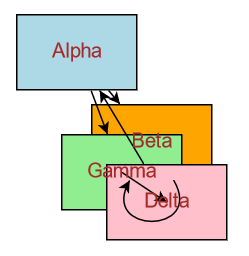
NEW: Node labels always in front
<!DOCTYPE html>
<html>
<head>
<title>Nodes whose labels are in a different Layer</title>
<!-- Copyright 1998-2022 by Northwoods Software Corporation. -->
</head>
<body>
<div id="myDiagramDiv" style="border: solid 1px black; width:100%; height:400px"></div>
<script src="https://unpkg.com/gojs"></script>
<script id="code">
const $ = go.GraphObject.make;
const myDiagram =
$(go.Diagram, "myDiagramDiv",
{ "undoManager.isEnabled": true });
// These Nodes always have an Adornment acting as a label
// Being a separate Part, the Adornment can be in a different Layer,
// thereby allowing them to always be in front of all Nodes.
class LabelAdornmentNode extends go.Node {
// The template is a static variable on the class
// It should be the result of calling copyTemplate(true) on an Adornment.
// NOTE: the use of an Adornment means that it does not behave like the typical Node,
// including responding to events without special handling.
static labelTemplate = null;
updateAdornments() {
super.updateAdornments();
if (LabelAdornmentNode.labelTemplate === null) return;
var ad = this.findAdornment("LABEL");
if (ad === null) {
// each Link must have its own copy of the labelTemplate
ad = LabelAdornmentNode.labelTemplate.copy();
ad.adornedObject = this;
this.addAdornment("LABEL", ad);
}
}
}
// end of LabelAdornmentNode
myDiagram.nodeTemplate =
$(LabelAdornmentNode,
new go.Binding("location", "loc", go.Point.parse),
$(go.Shape,
{ fill: "white", width: 80, height: 50 },
new go.Binding("fill", "color"))
);
LabelAdornmentNode.labelTemplate =
$(go.Adornment, "Spot",
{ layerName: "Foreground" },
$(go.Placeholder),
$(go.TextBlock,
{ stroke: "brown" },
new go.Binding("text"))
).copyTemplate(true); // copy the Bindings and prepare it for efficient copying
myDiagram.model = new go.GraphLinksModel(
[
{ key: 1, text: "Alpha", color: "lightblue", loc: "0 0" },
{ key: 2, text: "Beta", color: "orange", loc: "50 60" },
{ key: 3, text: "Gamma", color: "lightgreen", loc: "30 80" },
{ key: 4, text: "Delta", color: "pink", loc: "60 100" }
],
[
{ from: 1, to: 2 },
{ from: 1, to: 3 },
{ from: 2, to: 2 },
{ from: 3, to: 4 },
{ from: 4, to: 1 }
]);
</script>
</body>
</html>
